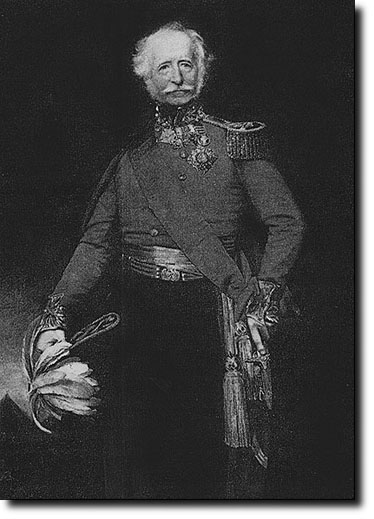|
Gough was a colourful and controversial figure who commanded the army in both the first China War and the Sikh Wars. The second Sikh War was almost his undoing but he prevailed in the end. He drew criticism for being tolerant of high levels of casualties and was well known to favour the use of the bayonet in battle. But he was well loved and respected by his men.
Full-Length Portrait
The painting of Lord Gough shows him apparently directing operations during the Sikh wars but he posed for it in England in 1854, wearing his famous white 'battle coat' and sun hat which made him more conspicuous in the fog of battle. The decorations on his chest include the star of the Order of the Bath and two medal ribbons for China and Gwalior. The painter was Sir Francis Grant.
Personal Life
He was born in Ireland on 3rd November 1779 and later claimed to have had a childhood tainted by neglect. In 1807 he married Frances Maria Stephens to whom he wrote many letters during his career. It was a 56 year marriage that ended with her death in March 1863. They had a son on 9th December 1810 but he died in infancy while Gough was fighting in the Peninsula. However, whilst he was living the life of a country squire, in Ireland, from 1817 to 1829, he and his wife had another son and three daughters.
Military Career
1792 Commissioned into the Limerick Militia aged 13.
1794 Adjutant in 119th Foot
1795 Transferred to the 2nd Battalion 76th Highlanders
1795 First campaign at Cape of Good Hope
1796 Transferred to 87th Foot (his favourite regiment)
1796 Campaigning in West Indies, St Lucia, Trinidad, Peurto Rico and Surinam.
1803 Captain.
1805 Major in 2nd Battalion 87th.
1809 Commanded his battalion in Peninsula
1809 July. Wounded at Talavera
1811 Battle of Barrosa. 87th capture French eagle.
1811 Siege of Tarifa where Gough's battalion played a significant part.
1812 Placed in command of garrison at Tarifa
1813 Battle of Vittoria
1813 Seriously wounded in the hip at Nivelle
1815 Knighted and made Lieutenant-Colonel
1817 His battalion was disbanded. Gough went on half-pay for 12 years.
1819 Promotion to Colonel whilst not serving
1829 Returned to duty and served in Ireland 'suppressing outrages'.
1830 Major-General
1837 Command of Mysore Division in Madras
1839 Appointed Colonel of 99th Foot
1841 Appointed Colonel of 87th Foot
1841 Sent to China as commander of British Expeditionary force.
1842 Appointed Commander-in-Chief in India
1843 Gwalior campaign
1845 First Sikh War
1846 Raised to the Peerage
1848 Second Sikh War
1849 Battle of Chillianwallah, 13th January.
1849 Gough relieved of his command because of high casualty figures.
1849 Slowness of communication meant that Gough did not know of the decision to sack him and he commanded the British at Gujerat a successful battle which ended the Sikh Wars.
1854 General. Appointed Colonel of 60th Rifles.
1855 Colonel of Royal Horse Guards and Gold Stick
1857 Knight of St Patrick and member of Privy Council
1861 Knight Grand Commander of the Order of the Star of India
1862 Field Marshal
1869 Died on 2nd March aged 90
Tribute
Sir Charles Napier had been sent out to India to replace him as Commander-in-Chief but was pleased to find that Lord Gough had saved his reputation at Gujerat. He said of him: "I like that noble old fellow Gough more than ever. I told him that my wish was that he would order me home; it would be a kindness, and so saying I told him the truth... Again, let me express my delight with old Gough; he is so good, so honest, so noble-minded."
| 

